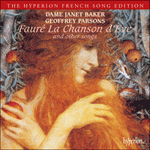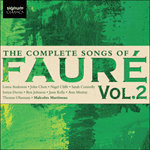The work of Baudelaire was published in dribs and drabs: the first edition of the
Fleurs du mal is dated 1857, and the second, augmented, edition 1861. But it was only after the death of the poet that a third ‘definitive’ edition was published that included the
Nouvelles fleurs du mal and a collection entitled
Les Épaves. It is in the latter, under the sub-section ‘Galanteries’, that
Hymne (and
La rançon, also set by Fauré) are to be found. It is the appearance of this volume in 1868 that must have excited Fauré into musical action, at more or less the same time as Duparc and Chabrier set
L’invitation au voyage. Fauré’s discovery of the poet surely dates from this time, and Baudelaire must have seemed to him ‘hot off the press’. It is clear that in
Hymne Fauré created a musical context that suggests the salon, and is too lightweight for the poet’s passionate sentiments. The gentle tremolos of the piano-writing are too soft-grained, and the composer’s natural charm is rendered leaden by a lyric that seems to embarrass him in its intensity. Jean-Michel Nectoux also notes a ‘lack of discretion or variety in the accentuation of the words’; the two evenly stressed dotted crotchets of bar 9 (‘À l’ange’) are a case in point. Fauré leaves out the poet’s third verse and opts simply to repeat the first verse at the end of the song instead of setting the poet’s fifth strophe which modifies the first. Jankélévitch sees in this music a trace of the melodic elan that we find in full measure in the A major Sonata for violin and piano, Op 13, but this may be wishful thinking.
from notes by Graham Johnson © 2005
Les Fleurs du mal de Charles Baudelaire furent publiées petit à petit: l’édition princeps, datée de 1857, fut suivie d’une deuxième édition augmentée (1861), mais ce fut seulement après la mort du poète que parut une troisième édition «définitive», incluant les
Nouvelles fleurs du mal et un recueil intitulé
Les épaves.
Hymne (mais auss
La rançon, texte d’une autre mélodie fauréenne) figure dans la sous-section «Galanteries» de ce volume, dont la parution, en 1868, incita certainement Fauré à l’action musicale, alors même que Duparc et Chabrier mettaient en musique
L’Invitation au voyage. Fauré, lui, découvrait alors Baudelaire, à ses yeux «tout frais sorti des presses». Pour
Hymne, il créa à l’évidence un contexte musical évoquant le salon, trop léger pour les sentiments passionnés du poète. Les tranquilles trémolos de l’écriture pianistique sont en effet d’un grain trop doux, et le compositeur voit son charme naturel plombé par des paroles dont l’intensité même semble l’embarrasser. Et Jean-Michel Nectoux de souligner «un manque de discrétion ou de variété dans l’accentuation des mots», qu’illustrent bien les deux noires pointées, uniformément accentuées, de la mesure 9 («À l’ange»). Fauré délaisse la troisième strophe du poème et décide juste de conclure la mélodie sur une répétition de la strophe initiale, éludant ainsi la cinquième strophe verlainienne, qui modifie la première. Jankélévitch voit dans cette musique une ébauche de l’élan mélodique qui se donnera pleine carrière dans la Sonate pour violon et piano en la majeur, op.13—mais peut-être prend-il ses désirs pour des réalités.
extrait des notes rédigées par Graham Johnson © 2005
Français: Hypérion


 Fauré: La chanson d'Ève & other songs
Fauré: La chanson d'Ève & other songs Fauré: The Complete Songs, Vol. 2
Fauré: The Complete Songs, Vol. 2 Voyages
Voyages
